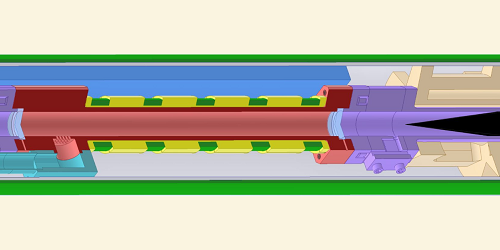
The neutrino is an elusive subatomic particle that passes effortlessly through normal matter and plays an outsized role among the particles that comprise our universe. To fully explain how our universe came to be, we need to know its mass. But, like so many of us, it avoids being weighed.
An international team of researchers from the Project 8 experiment, including researchers from Yale’s Wright Lab, is reporting the first measurement of neutrino mass using a novel technique called Cyclotron Radiation Emission Spectroscopy (CRES). Once fully scaled up, Project 8 could provide the most sensitive method for a direct laboratory measurement of neutrino mass.
Members of the Wright Lab Project 8 team include Karsten Heeger, the Eugene Higgins Professor of Physics, chair of the Department of Physics, and a principal investigator for Project 8; graduate students Arina Telles and Talia Weiss; postdoctoral associate Pranava Teja Surukuchi; associate research scientist Penny Slocum; research scientist James Nikkel; and research associate Luis Saldana.
Project 8 at Wright Lab
The Project 8 collaboration has spent years figuring out how to accurately tease out the electron signals from electronic background noise. Wright Lab has played a leading role at the very last stage of the process: placing an upper limit on how heavy the neutrino can be. The Wright Lab team recently led one of two main Project 8 analyses. Project 8 has published a paper, which includes the Wright Lab analysis, that places limits on the neutrino mass derived from the CRES technique for the first time.
Weiss said, “The neutrino is incredibly light. It’s more than 500,000 times lighter than an electron. So, when neutrinos and electrons are created at the same time, the neutrino mass has only a tiny effect on the electron’s motion. We want to see that small effect. So, we need a super precise method to measure how fast the electrons are zipping around.”
Weiss continued, “Project 8 has developed a highly precise CRES detector. We can tell what energy an electron has to a precision of about one electron-volt. That’s tiny. If you eat a single Cheez-It, your body will gain 100,000,000,000,000,000,000 electron-volts of energy (a.k.a. 5 calories).”
In addition to placing an upper limit on how heavy the neutrino can be, the Wright Lab group has been involved in various aspects of the experiment, including: operating the CRES apparatus, developing algorithms for data analysis, working on detailed simulations, and developing the next prototype experiment on the way to a future full-scale Project 8 experiment.
Future plans for Project 8
Weiss said, “In the long run, Project 8 aims to build a CRES detector with a precision 10-to-20 times better than it is currently… to weigh neutrinos as light as 10 million times lighter than the electron.”
Weiss continued, “The Yale group [has also] harnessed Project 8’s recent data to test new methods — based on artificial intelligence (AI/ML) — that identify the special signature of light from a CRES electron. AI/ML methods will likely be essential as Project 8 works to achieve higher precision.”
Heeger said, “Now that we have demonstrated that CRES can be used to measure neutrino mass, the goal is to develop an experiment sensitive enough to reach beyond the sensitivity of current laboratory experiments at a fraction of an electron volt. This will require scaling up the CRES technique to larger volumes…This work will require innovative technical, computing, and analysis solutions, and we are excited to build the first large-volume demonstrator here at Wright Lab in the coming years.”
Project 8 is supported by the U.S. Department of Energy Office of Science, Office of Nuclear Physics, the National Science Foundation, the German Research Foundation PRISMA+ Cluster of Excellence, and internal investments by collaborating institutions.
This article has been taken from the Wright Lab news story of September 12, 2023, by Victoria Misenti, which was adapted from a PNNL news release, “Closing in on the Elusive Neutrino,” by Karyn Hede and a Yale News Q&A by Jim Shelton, “Project 8 takes on the mystery of neutrino mass”. For more information, please see the links below.